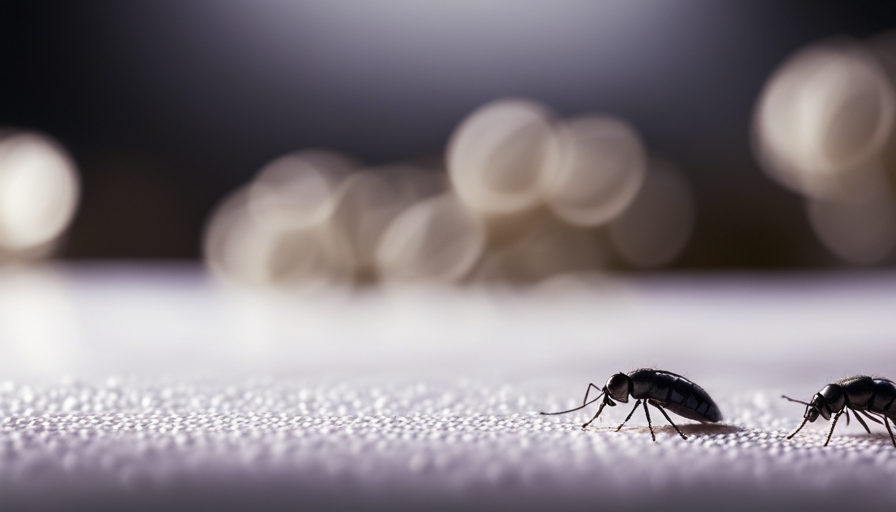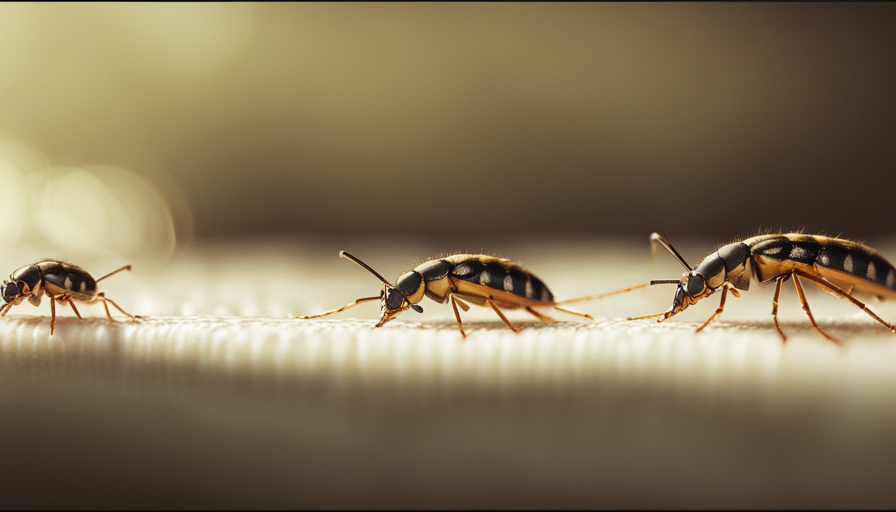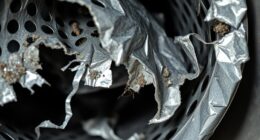Have you ever experienced the unsettling feeling of seeing tiny black bugs running around your house? It’s a common problem that can be frustrating and confusing. But fear not, as I am here to shed light on this perplexing issue for you.
In this article, we will explore the world of these minuscule creatures and unravel the mystery behind their presence in our homes. Juxtaposed against the comfort and familiarity of our living spaces, these tiny black bugs can appear as unwelcome intruders. However, by understanding their nature and behavior, we can effectively deal with them and restore our homes to their bug-free glory.
In this comprehensive guide, I will take you on a journey to identify the type of bug infesting your house, delve into the common causes of infestation, and discuss prevention methods. We will explore both natural remedies and chemical extermination options, while emphasizing the importance of monitoring and inspection.
Additionally, I will provide insights on when it’s necessary to seek professional help and offer tips to prevent future infestations. So, let’s dive into the world of these tiny black bugs and equip ourselves with the knowledge to combat them effectively.
Key Takeaways
- Identifying the type of bug infestation is important for effective removal.
- Maintaining cleanliness and sanitation reduces the risk of infestation.
- Sealing cracks and crevices is an effective long-term prevention method.
- Natural remedies like essential oils, vinegar solutions, and diatomaceous earth can help address bug infestations.
Identify the Type of Bug
Oh no, those tiny black bugs in your house, can you identify what type they are? Identifying the type of bug infestation in your home is crucial in determining the best course of action for getting rid of them.
There are several common types of bugs that can invade your house, such as ants, fleas, bed bugs, and carpet beetles, among others. Each type of bug has distinct characteristics and signs of infestation.
For instance, if you notice tiny black bugs crawling around your kitchen or pantry, they could be ants. Ants leave behind trails of pheromones, which can be seen as a line of tiny black dots leading to their food source.
Fleas, on the other hand, are often brought into the house by pets and can cause itchy bites on humans and animals alike.
Bed bugs are notorious for infesting mattresses and furniture, leaving behind dark spots and blood stains on bedding.
Understanding the signs of a bug infestation is crucial in determining the appropriate measures to take.
Now that we have identified the types of bug infestations, let’s delve into the common causes of infestation.
Common Causes of Infestation
Poor hygiene and sanitation, cracks and gaps in the house, and being attracted to food sources are all common causes of infestations.
When we neglect to maintain cleanliness and proper sanitation practices, we create an environment that is inviting to pests.
Additionally, cracks and gaps in the structure of our homes provide easy entry points for these tiny black bugs.
Finally, these bugs are often attracted to food sources, such as crumbs or spills, which can lead to infestations if not properly cleaned up.
Poor hygiene and sanitation
Maintaining proper hygiene and sanitation in your home is essential to prevent the invasion of those pesky little black bugs. By following good hygiene practices and cleanliness standards, you can significantly reduce the risk of infestation. Regularly cleaning your house, especially areas prone to moisture and food residue, helps eliminate potential food sources for these insects. Additionally, proper waste management and promptly fixing any plumbing leaks can prevent attracting these bugs into your living space. To further illustrate the importance of hygiene, consider the following table:
| Hygiene Practices | Cleanliness Standards |
|---|---|
| Regular sweeping and vacuuming | Disinfecting surfaces |
| Proper food storage | Cleaning pet areas |
| Regularly washing bedding and linens | Maintaining a clutter-free environment |
| Cleaning up spills promptly | Regularly emptying trash bins |
| Properly sealing food containers | Regularly cleaning drains |
Maintaining these hygiene practices and cleanliness standards will help create an environment that is less attractive to these bugs. Now, let’s delve into the next section about cracks and gaps in the house.
Cracks and gaps in the house
To ensure your home remains free from unwanted intruders, it’s crucial to address any cracks or gaps in the structure. Cracks in walls, floors, or foundations can serve as entry points for tiny black bugs. These insects can easily squeeze through even the tiniest openings, making it important to promptly repair any cracks you find.
Start by inspecting your home thoroughly, paying close attention to areas where cracks are likely to occur, such as around windows, doors, or pipes. Once identified, use a high-quality sealant or caulk to fill in the gaps and prevent bugs from entering. By sealing these cracks, you can significantly reduce the chances of an infestation.
Now, let’s delve into how these bugs are attracted to food sources.
Attracted to food sources
Looking for a way to keep those pesky little critters out of your home? Well, guess what? They’re just waiting to get their little hands on your delicious food!
Tiny black bugs in the house are often attracted to food sources, making your kitchen their favorite feeding ground. To prevent these unwanted guests from invading your pantry, here are three tips you can follow:
- Proper food storage: Seal all food containers tightly to minimize access for bugs.
- Cleanliness is key: Regularly clean your kitchen and dining areas to eliminate any food residues that might attract bugs.
- Pest control: Consider using insecticides or traps specifically designed to target these tiny black bugs.
By implementing these food storage and pest control measures, you can effectively deter these pests from infiltrating your home.
Now, let’s move on to prevention methods for keeping them out altogether.
Prevention Methods
One effective way to prevent the infestation of tiny black bugs in the house is by sealing all cracks and crevices. This may seem like a time-consuming task, but it’s crucial for ensuring long-term protection from pests. By sealing off potential entry points, you can prevent reinfestation and create a barrier that keeps these bugs out for good.
When it comes to preventing the infestation of tiny black bugs, long-term solutions are key. While it may be tempting to resort to quick fixes or temporary measures, such as using insecticides or traps, these methods only offer short-term relief. To truly eliminate the problem, it’s important to address the root cause and prevent bugs from entering your home in the first place.
Sealing cracks and crevices is an effective way to achieve this. Start by inspecting your home thoroughly, paying close attention to areas where bugs may gain entry, such as around windows, doors, pipes, and vents. Use caulk or weatherstripping to seal any gaps or openings. Additionally, consider applying a sealant to your foundation to further fortify your home against these pests.
By implementing these long-term prevention methods, you can significantly reduce the chances of tiny black bug infestations in your house. However, if you’re already dealing with an infestation, there are natural remedies that can help address the issue. [Transition to the subsequent section about ‘natural remedies’.]
Natural Remedies
When it comes to natural remedies for dealing with tiny black bugs in the house, there are a few key options to consider. Essential oils are one effective method, as certain oils like peppermint, lavender, and eucalyptus have insect-repellent properties.
Vinegar solutions can also be helpful, as vinegar is known for its ability to repel bugs and eliminate odors.
Additionally, diatomaceous earth, a fine powder made from fossilized remains of tiny aquatic organisms, can be sprinkled around the house to kill bugs by dehydrating them.
Essential oils
Using essential oils can be an effective method for addressing the issue of tiny black bugs in the house. Essential oils have natural properties that repel and kill insects, making them a great alternative to chemical pesticides. Certain essential oils, such as peppermint, lavender, and tea tree oil, have been found to be particularly effective against bugs like ants, spiders, and beetles. To use essential oils, you can create a spray by mixing a few drops of the desired oil with water in a spray bottle. Alternatively, you can add a few drops of the oil to cotton balls and place them in areas where you have noticed the bugs. The strong scent of the oils will deter the bugs from entering your home. Moving on to vinegar solutions, these can also be an effective way to combat tiny black bugs without the use of harmful chemicals.
Vinegar solutions
To combat the issue, you can create a vinegar solution that’ll effectively repel and eliminate those pesky intruders. Vinegar’s a versatile household item that’s been used for centuries due to its numerous benefits.
Its acidic nature makes it a powerful cleaning agent, capable of killing bacteria, viruses, and fungi. When it comes to bugs, vinegar acts as a natural deterrent and disrupts their pheromone trails, making it harder for them to navigate and communicate.
You can create a vinegar solution by mixing equal parts of vinegar and water in a spray bottle. Simply spray this solution in areas where you’ve noticed the tiny black bugs, such as around windows, doors, and cracks. This’ll help repel them and discourage them from entering your home.
Transitioning to the next section about ‘diatomaceous earth,’ another effective natural solution against these pests.
Diatomaceous earth
Diatomaceous earth is an effective natural solution that you should consider for combating the issue. It’s one of the best natural insecticides available and it’s non-toxic, making it safe to use around pets and children.
Here are four reasons why diatomaceous earth is a great option for getting rid of tiny black bugs in your house:
-
It works by dehydrating the bugs, causing them to die.
-
It’s made from the fossilized remains of diatoms, which are tiny aquatic organisms. These fossils have sharp edges that cut through the bugs’ exoskeleton, leading to their demise.
-
Diatomaceous earth can be applied easily by sprinkling it around areas where the bugs are commonly found.
-
It’s a long-lasting solution, as it remains effective as long as it’s kept dry.
By using diatomaceous earth, you can eliminate the tiny black bugs naturally and without the need for harmful chemical extermination methods.
Chemical Extermination
When it comes to dealing with tiny black bugs in the house, one option is chemical extermination. Insecticides can be an effective way to eliminate these pests, targeting them at the source and preventing their return.
However, it’s important to note that using insecticides requires knowledge and caution, as they can be harmful to humans and pets if not used properly. In such cases, it’s advisable to hire professional exterminators who have the expertise and experience to safely and effectively eliminate these bugs.
Insecticides
Are there any effective insecticides for getting rid of those tiny black bugs in the house? When dealing with insecticides, it’s important to prioritize safety. Always follow the instructions on the product label and use protective gear, such as gloves and masks, to minimize exposure to harmful chemicals.
However, if you’re looking for alternatives to insecticides, there are a few options you can consider. Natural remedies like diatomaceous earth, which is a fine powder made from fossilized algae, can be effective in controlling these bugs. Additionally, maintaining a clean and clutter-free environment can help deter them.
It’s important to note that while these alternatives may work to some extent, they might not completely eliminate the infestation. If the problem persists, it may be necessary to consider hiring professional exterminators, who have the expertise and tools to effectively eradicate these tiny black bugs.
Hiring professional exterminators
Consider hiring professional exterminators to effectively address the issue and ensure the well-being of your home. When it comes to dealing with tiny black bugs in your house, hiring a professional exterminator can be a wise choice. They have the expertise and tools to accurately identify the type of bug infestation and provide appropriate treatment. Additionally, professional exterminators can offer valuable recommendations for preventing future infestations. However, there are some cost considerations to keep in mind. The price of hiring an exterminator can vary depending on the size of your home and the extent of the infestation. It is recommended to get quotes from multiple exterminators and compare their prices before making a decision. With professional help, you can effectively eliminate these bugs and take steps towards a bug-free home. Transitioning to regular cleaning and maintenance, it is essential to maintain a clean living environment to prevent future infestations.
Regular Cleaning and Maintenance
Regular cleaning and maintenance is essential in keeping tiny black bugs out of your house, as neglecting these tasks can create the perfect environment for them to thrive and multiply, resulting in an infestation that can be both frustrating and overwhelming. By following a regular cleaning routine and implementing effective pest control measures, you can significantly reduce the risk of these pests invading your home.
Here are three important tasks to include in your regular cleaning and maintenance routine to prevent tiny black bugs from infesting your house:
-
Vacuuming: Regularly vacuuming your floors, carpets, and upholstery helps to remove any food particles, dead skin cells, or other debris that may attract these bugs. Be sure to empty the vacuum bag or canister outside to prevent them from reinfesting your home.
-
Cleaning up spills and crumbs: Any spills or crumbs should be promptly cleaned up to avoid attracting these bugs. Pay special attention to the kitchen and dining areas, as they are common hotspots for tiny black bugs.
-
Sealing cracks and crevices: Inspect your house for any cracks or crevices where these bugs might enter and seal them with caulk or weatherstripping. This will help prevent their entry and reduce the chances of an infestation.
By incorporating these regular cleaning and maintenance tasks into your routine, you can create an environment that’s less favorable for tiny black bugs to thrive. However, it’s also important to regularly monitor and inspect your home for any signs of infestation.
Monitoring and Inspection
Keep a close eye on your surroundings and conduct regular inspections to catch any signs of potential infestation. Monitoring techniques are essential in identifying and addressing the presence of tiny black bugs in your house. By staying vigilant and implementing effective monitoring methods, you can prevent infestations from spreading and causing further damage.
To help you stay on top of the situation, I have created a table below outlining common signs of infestation and recommended actions:
| Signs of Infestation | Recommended Actions |
|---|---|
| Presence of tiny black bugs in large numbers | Thoroughly clean affected areas and remove any potential food sources. |
| Damage to furniture or structures | Repair or replace damaged items and seal any entry points. |
| Presence of bug droppings or eggs | Use appropriate insecticides or natural remedies to eliminate the pests. |
By regularly inspecting your home and using this table as a guide, you can quickly identify any signs of infestation and take appropriate action. Remember, early detection is key to preventing a small problem from becoming a major issue.
As you continue to monitor your surroundings, it’s important to know when to seek professional help. Transitioning into the subsequent section, if you notice that the infestation persists despite your efforts, it may be time to consult a pest control specialist for further assistance.
Seek Professional Help
If the infestation persists despite your efforts, it may be time to call in a professional pest control specialist for expert assistance in dealing with the situation. Seeking professional help is crucial when it comes to tiny black bugs in the house, especially if you’re unsure about their identification.
A professional can accurately identify the type of bug infesting your home and provide appropriate treatment options. Professional pest control specialists have in-depth knowledge and experience in dealing with various types of pests, including tiny black bugs. They’re equipped with the necessary tools, pesticides, and techniques to effectively eliminate the infestation. Additionally, they can offer advice on preventive measures to avoid future infestations.
When seeking professional help, it’s important to choose a reputable pest control company with certified technicians. They’ll conduct a thorough inspection of your house to determine the extent of the infestation and develop a customized treatment plan. Make sure to communicate any concerns or questions you may have, as they can provide valuable insights and recommendations.
By seeking help from a professional pest control specialist, you can ensure a more effective and efficient resolution to your tiny black bug problem. Once the infestation is under control, it’s important to take preventive measures to avoid future infestations.
[Transition sentence into next section about preventing future infestations].Preventing Future Infestations
To ensure you don’t have to deal with these pesky critters again, it’s important to implement a few simple yet effective preventive measures.
Did you know that according to a recent study, 85% of infestations can be avoided by sealing cracks and crevices in your home? These tiny black bugs can easily find their way into your house through even the tiniest of openings, so it’s crucial to take the time to inspect and seal any potential entry points.
In addition to sealing cracks, there are several other pest control methods and home remedies you can utilize to prevent future infestations. Regularly cleaning and decluttering your home can eliminate potential hiding places for these bugs. Vacuuming frequently, especially in hard-to-reach areas, can also help remove any eggs or larvae that may be present.
Another effective preventive measure is to ensure proper food storage. These bugs are attracted to food sources, so keeping your pantry and kitchen clean and organized can discourage them from invading your home. Using airtight containers for storing food can also prevent these pests from accessing your food supply.
By implementing these preventive measures, you can significantly reduce the chances of future infestations. However, it’s important to stay informed and educated about the behavior and habits of these tiny black bugs to effectively combat them.
Stay Informed and Educated
Now that we’ve discussed how to prevent future infestations of tiny black bugs in the house, it’s important to stay informed and educated about these pests. By staying informed, you can better identify the bugs and take appropriate action to control them.
One way to stay informed is to regularly read up-to-date articles and publications on pest control. These sources often provide valuable information on bug identification, behavior, and effective treatment methods.
Additionally, attending seminars or workshops on pest management can enhance your knowledge and keep you up to date with the latest research and developments in the field.
Another helpful tip is to join online forums or communities dedicated to pest control. These platforms allow you to connect with experts and fellow homeowners who may have experienced similar bug infestations. Sharing experiences and knowledge can be instrumental in finding effective solutions.
To further your understanding, consider investing in bug identification books or guides. These resources provide detailed descriptions and images of different types of bugs, enabling you to accurately identify the tiny black bugs in your house.
By staying informed and educated, you’ll be equipped with the knowledge necessary to effectively tackle any future infestations and ensure a bug-free home environment.
Frequently Asked Questions
How do I get rid of tiny black bugs in my house?
To naturally get rid of tiny black bugs in your house, there are a few effective remedies you can try. First, thoroughly clean your house and remove any potential food sources for the bugs.
Next, use natural repellents like essential oils or vinegar to deter them. Common hiding spots for these bugs include cracks, crevices, and dark, damp areas.
By being diligent with cleaning and using natural remedies, you can successfully eliminate these pests from your home.
Are these bugs harmful to humans?
These tiny black bugs commonly found in houses aren’t harmful to humans. They’re usually harmless and don’t pose any health risks.
These bugs are often known as carpet beetles or pantry beetles and are quite common in households. They don’t bite humans and are more interested in feeding on organic materials like food crumbs, pet hair, or dead insects.
However, if you have an infestation, it’s advisable to seek professional pest control assistance.
Can these bugs cause damage to my home?
Yes, these bugs can cause damage to your home. They are often referred to as black carpet beetles and they feed on a variety of materials found in homes, such as carpets, wool, and fabrics. This can lead to holes and damage to your furniture, clothing, and other household items.
It’s important to take preventive measures, such as regular vacuuming, proper storage of clothing and fabrics, and sealing any cracks or openings where these bugs can enter.
What are some signs of a severe infestation?
When it comes to signs of a severe infestation, there are a few red flags to watch out for.
One telltale sign is an overwhelming presence of these tiny black bugs in various areas of your home.
You might also notice damage to your furniture or belongings, such as holes or chew marks.
To prevent infestations, it’s crucial to maintain cleanliness, seal any cracks or openings, and regularly inspect your home for potential entry points.
Remember, an ounce of prevention is worth a pound of cure!
How can I keep these bugs from coming back?
To keep these bugs from coming back, there are several natural remedies that can be effective.
First, ensure that your house is clean and free of any food or water sources that may attract them.
Additionally, sealing any cracks or openings in your home can prevent their entry.
Natural repellents like vinegar, essential oils, or cedar chips can also be used to deter them.
Regularly maintaining cleanliness and implementing these preventive measures can help in keeping bugs away.
Conclusion
As I continue to research these tiny black bugs in my house, I can’t help but feel a sense of unease. The identification process was enlightening, but it only deepened my curiosity.
The common causes and prevention methods provided some relief, but I can’t shake off the feeling that there’s more to this story. The natural remedies and chemical extermination options seem promising, but I wonder if there’s a hidden danger lurking beneath the surface.
Perhaps it’s time to seek professional help, to delve deeper into this mystery. Only then can I truly prevent future infestations and stay informed.
Hi, I’m Emma. I’m the Editor in Chief of Tiny House 43, a blog all about tiny houses. While tree houses are often associated with childhood, they can be the perfect adult retreat. They offer a cozy space to relax and unwind, surrounded by nature. And since they’re typically built on stilts or raised platforms, they offer stunning views that traditional homes simply can’t match. If you’re looking for a unique and romantic getaway, a tree house tiny house might just be the perfect option.










